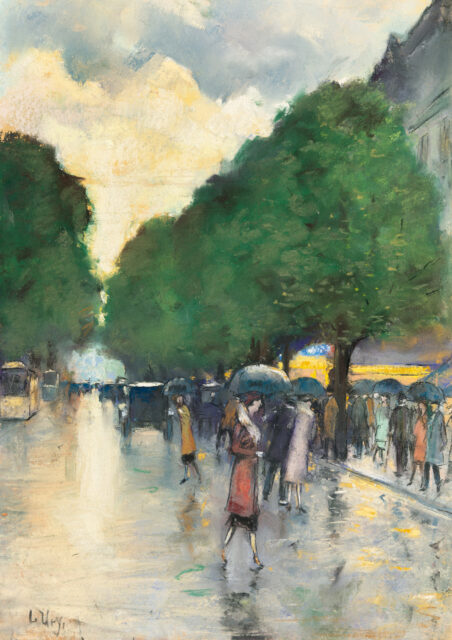Autumn street scene in the rain, Berlin
Details
With a photo expertise by Dr. Sibylle Groß, Berlin, dated 30.10.2019 and detailed documentation (copy); this pastel will be included in the forthcoming Catalogue Raisonné of works by Lesser Ury. Literature: Müller-Mehlis, Reinhard, Vorschau auf die 18. Kunst & Antiquitäten Messe Hannover, in: Die Weltkunst, 56. year no. 6, 25.3.1986, with col. illus. p. 826 (“Berlin, Kurfürstendamm”). Exhibitions: Eröffnungsausstellung, Galerie Klauspeter Westenhoff, Hamburg 1985, with col. illus. p. 69 (“Unter den Linden”). Provenance: Galerie Klauspeter Westenhoff, Hamburg, 1985/86; Galerie Schwarzer, Düsseldorf; private collection, West Germany, acquired from the aforementioned in 1986 (subsequently in family ownership, private ownership, Rhineland); private collection, Berlin.
Description
• Ury began to focus his attention on the west of Berlin already before the First World War
• Atmospheric depiction of the Berlin of the “Golden Twenties”
• Ury captures the atmosphere of the city in this impressive work
In her documentation from 30 October 2019, Dr Sibylle Groß writes: “The pastel was created in the late 1920s, Berlin’s Golden Twenties between 1924 and 1929, a period of economic boom that came to an end with the Great Depression, beginning with the New York stock market crash in October 1929. ‘The Golden Twenties are legendary. Back then, Berlin was a vibrant metropolis with over four million inhabitants. Loud, dazzling restlessness characterised the attitude to life in the third largest city in the world. After experiencing the war and overcoming inflation, people threw themselves into entertainment. Silent films with orchestra in the UFA-Palast, theatre on Kurfürstendamm (…)’ Berlin’s attitude to life manifested itself above all in the west of the city, on Kurfürstendamm and its immediate surroundings. ‘The Kurfürstendamm became an entertainment district. Luxury shops were established, as well as a large number of restaurants, coffee houses, hotels, pubs, wine bars, cafés, dance halls, snack bars, cinemas (some of which gave rise to large cinemas such as the Marmorhaus, Capitol and Universum), cabarets and other entertainment establishments (…). Kurfürstendamm thus developed into one of the busiest boulevards in the imperial capital and the centre of the ‘New West’, now also known as West-City, which extended from Wittenbergplatz, Budapesterstrasse and Tauentzienstraße to Zoologischer Garten station, the Memorial Church and Kurfürstendamm. The street view depicted in this pastel can no longer be precisely determined today. In his later creative years, the artist adhered less and less strictly to the depiction of concrete reality, prioritising painterly aspects over real references. Looking back, the engineer Karl Schapira, perhaps the artist’s greatest collector during his lifetime, described this phenomenon in a letter with apt words: ‘You know that L.U. (Lesser Ury) was technically, i.e. for technical things like railways, cars, electricity in any form, an absolute ignoramus. He didn’t have the slightest feeling for it or any knowledge of it. His eye took in these things as they presented themselves to his gaze, but not to his understanding, and then he reproduced them from memory.’ Although the view shown in the pastel cannot be clearly localised in the Berlin cityscape of the 1920s, it is probably one of the streets of the ‘New West’. Lesser Ury first began to focus his attention on the west of Berlin in the years immediately before the First World War, and in the 1920s, when the Kurfürstendamm became the business and entertainment mile par excellence, Lesser Ury created a series of views showing the boulevard. On the right-hand edge of this pastel, a tightly packed crowd of people under umbrellas can be seen standing in a row. Above their heads, neon signs appear in yellow and blue. This could be one of the many cinemas where silent films were first shown, followed by the first sound films. The new large cinemas were built on Kurfürstendamm at the end of the silent film era. Even during the First World War, the cinema became one of the most effective forms of mass media. The 1920s are still regarded today as the high point of German cinematic art.”
* All results incl. buyer’s premium (27%) without VAT. No guarantee, subject to error.
** All post-auction prices excl. buyer's premium and VAT. No guarantee, subject to error.
*** Conditional Sale: The bid was accepted below the limit. Acquisition of the work may still be possible in our post-auction sale.
R = regular taxation
N = differential taxation on works of art which originate from a country outside of the EU
The private or commercial use of images shown on this Website, in particular through duplication or dissemination, is not permitted. All rights reserved.


